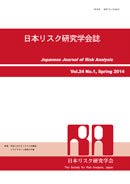24 巻, 1 号
選択された号の論文の11件中1~11を表示しています
- |<
- <
- 1
- >
- >|
巻頭言
-
原稿種別: 巻頭言
2014 年24 巻1 号 p. 1-3
発行日: 2014/06/30
公開日: 2014/07/15
PDF形式でダウンロード (275K)
特集 学会におけるリスク人材養成―リスクマネジャ制度の今後
総説論文
-
原稿種別: 総説論文
2014 年24 巻1 号 p. 5-9
発行日: 2014/06/30
公開日: 2014/07/15
PDF形式でダウンロード (602K) -
原稿種別: 総説論文
2014 年24 巻1 号 p. 11-14
発行日: 2014/06/30
公開日: 2014/07/15
PDF形式でダウンロード (332K) -
原稿種別: 総説論文
2014 年24 巻1 号 p. 15-20
発行日: 2014/06/30
公開日: 2014/07/15
PDF形式でダウンロード (557K)
総説論文
-
原稿種別: 総説論文
2014 年24 巻1 号 p. 21-30
発行日: 2014/06/30
公開日: 2014/07/15
PDF形式でダウンロード (496K) -
原稿種別: 総説論文
2014 年24 巻1 号 p. 31-39
発行日: 2014/06/30
公開日: 2014/07/15
PDF形式でダウンロード (1237K) -
原稿種別: 総説論文
2014 年24 巻1 号 p. 41-48
発行日: 2014/06/30
公開日: 2014/07/15
PDF形式でダウンロード (713K)
原著論文
-
原稿種別: 原著論文
2014 年24 巻1 号 p. 49-59
発行日: 2014/06/30
公開日: 2014/07/15
PDF形式でダウンロード (775K)
資料論文
-
原稿種別: 資料論文
2014 年24 巻1 号 p. 61-66
発行日: 2014/06/30
公開日: 2014/07/15
PDF形式でダウンロード (799K)
書評
-
原稿種別: 書評
2014 年24 巻1 号 p. 67-68
発行日: 2014/06/30
公開日: 2014/07/15
PDF形式でダウンロード (230K) -
原稿種別: 書評
2014 年24 巻1 号 p. 69-70
発行日: 2014/06/30
公開日: 2014/07/15
PDF形式でダウンロード (239K)
- |<
- <
- 1
- >
- >|
